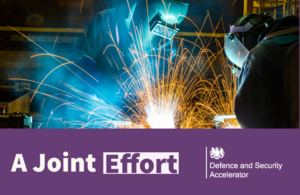‘A Joint Effort’ between the UK and Australia will fast-track innovative approaches to joining materials for Defence.
DASA and the Materials for Strategic Advantage programme recently held a joint showcase for the suppliers who gained funding via the second phase of the first parallel UK / AUS bilateral “A Joint Effort” call for innovation.

The culmination of four years’ collaborative work between UK and Australian defence was showcased at a Defence and Security Accelerator (DASA) event in March 2022. The event highlighted the technologies developed as part of the ‘A Joint Effort’ competition, which was launched to find innovative approaches for creating and managing joints and integrating novel materials onto military platforms.
Novel materials and improving the joining capabilities of these materials can offer significant benefits to military capability across land, sea and air, including increased functionality, availability and improved survivability.
UK and Australian innovators presented their findings from the second phase of ‘A Joint Effort’ and pitched their innovations to an audience of UK based technology integrators and Defence personnel. UK stakeholders were represented at the event and were able to gauge the maturity of the work and identify opportunities for “pull through” into specific projects and applications.
What was on show at the event?
The innovations on show at the event included:
From the UK:
- a new joining process for physical protection which will help produce armour more quickly and cost effectively
- an adhesive, inspired by the natural adhesives used by marine molluscs, which can adhere sensors to surfaces without interfering with sensor functions
- techniques to join dissimilar materials to perform at high temperatures, which could improve the operating performance of assets such as vehicles
- a multifunctional composite joint structure with enhanced damage tolerance and “self-repair” through crack closure
From Australia:
- new adhesive technology to develop reversible and on-demand bonding and de-bonding of components/materials by the addition of novel magnetic nanoparticles
- a novel non-destructive evaluation method for determining the performance and degradation of transparent armour materials, adhesives and systems using THz sensing
- novel modelling approaches for monitoring in situ damage tolerance, damage growth and residual limp home capability of composite joints to support digital twin applications
- novel technologies to enhance the strength of repaired metallic / composite sections through the use of additive manufacture and pinning, reducing the processing damage and increasing the durability of structural joints
- development of new composite resin systems for composite systems that significantly increase the durability of the final cured products as well as provide residual lightning strike protection to this class of material
How has the collaboration between Australia and the UK benefitted the project?
‘A Joint Effort’ demonstrates the possibility of engaging quickly with partners globally to identify and deliver high-risk, high-reward research. It is the first innovation competition of this kind and has developed methods and ways of working to enable further collaborative competitions across Defence and Security.
Many of the projects shown at the event have built on investments made during the first phase of the competition by extending their teams to include international partners and identifying exploitation routes across both nations. Several of the projects demonstrate true collaboration and aligned programmes of work because of this competition.
Olivia Samardzic, Minister Counsellor Defence Science and Technology, DSTG said: “By working bilaterally, we not only strengthen our science and technology relationship, through diversity of thoughts, burden, resource sharing and resilience, but we also provide support to each on each nation’s respective defence industries to overcome the capability challenges we both face. This allows us to deliver capability to the war-fighter that is better tested and delivered at a faster rate than if we acted alone.”
John Hunt, Australian Delivery Team Lead, Dstl said: “We got a tremendous amount of value from working with the Australians in this particular bilateral union. We’ve built up very strong relationships and been able to access a greater pool of innovation from Australian and UK researchers. Our respective indigenous Science and Technology bases are better as a result of this investment.”
The ‘A Joint Effort’ competition has been run in the UK and AUS through DASA and has been managed by the Defence Science and Technology Laboratory (Dstl) in the UK and Defence Science and Technology Group (DST Group) in Australia. The competition has been funded by the Small Business Innovation Research for Defence (SBIRD), part of the Next Generation Technologies Fund in Australia and the Materials for Strategic Advantage programme in the UK. Both nations used DASA as a common assessment framework.
How has this project helped the innovators?
When asked about their experience of being involved with the, ‘A Joint Effort’, project one supplier said: “The way DASA launches competitions and challenges ensures there’s visibility about what our technology could deliver, which is really critical. It helps tailor a project to focus on the end-users. DASA’s capability to support projects that are very early in their development has been critical for our growth as a start-up company. It is a risky business, taking technology from concept to proof of concept. DASA has enabled us to do that successfully.”
Another supplier noted: “Without the ‘A Joint Effort’ call, we would never have had the funding to progress our ideas. It would have been a nice idea that went nowhere.”
When asked about the next steps for their project, one supplier said: “We’ve demonstrated the potential of our idea, which hopefully will excite people that there’s more to come. We’ve got potential applications in a variety of areas. Developing strategic relationships with partners familiar with commercialising a finished product will help us navigate and de-risk the product development pathway we need to take.”
Another supplier commented: “We’ve got a patent application in process on the back of what we’ve learned and found out. There’s also more research to be done. We’ve opened a Pandora’s Box in terms of what we can use this technology for in both civilian and defence applications.”